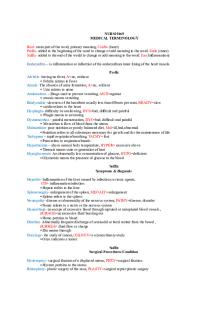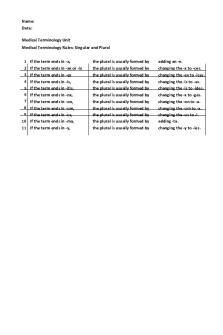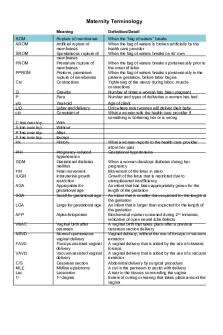Medical Terminology Ch. 9-14 Final Vocab PDF

| Title | Medical Terminology Ch. 9-14 Final Vocab |
|---|---|
| Author | Karlee Galcik |
| Course | Medical-Surgical Nursing |
| Institution | Miami Dade College |
| Pages | 21 |
| File Size | 164.5 KB |
| File Type | |
| Total Downloads | 106 |
| Total Views | 140 |
Summary
medical terminology definitions ...
Description
Chapter 9: Blood, Lymphatic, and Immune Systems Acute Posthemorrhagic Anemia: RBC deficiency caused by blood loss. B12 Deficiency: Insufficient blood levels of cobalamin, also called vitamin b12, which is essential for RBC maturation. Chronic Blood Loss: Long-term internal bleeding. Folate Deficiency: Anemia as a result of a lack of foliate from dietary, drug-induced, congenital, or other causes. Hypovolemia: Deficient volume of circulating blood. Sideropenia: Condition of having reduced numbers of healthy RBCs because fo chronic blood loss, inadequate iron intake,, or unspecified causes. Pernicious Anemia: Progressive anemia that results from a lack of intrinsic factor essential for the absorption of vitamin B12. Aplastic Anemia: Suppression of bone marrow function leading to a reductio in RBC production. Hemolytic Anemia: A group of anemias caused by destruction of RBCs. Autoimmune Acquired Hemolytic Anemia: Anemia caused by the body’s destruction of its own RBCs by serum antibodies. Non-autoimmune Acquired Hemolytic Anemia: Anemia that may be drug induced or may be caused by an infectious disease, in which the RBCs are destroyed. Sickle Cell Anemia: Inherited anemia characterized by crescent-shaped RBCs. Thalassemia: Group of inherited disorders of people of Mediterranean, African, and Southeast Asian descent, in which anemia is the result of a decrease in the synthesis of hemoglobin, resulting in decreased production and increased destruction of RBCs. Pancytopenia: Deficiency of all blood cells caused by dysfunctiontional stem cells. Hemophilia: Group of inherited bleeding disorders characterized by a deficiency of one of the factors necessary for the coagulation of blood. Polycythemia Vera: Chronic increase in the number of RBCs and the concentration of hemoglobin. Purpura: Bleeding disorder characterized by hemorrhage into the tissues. Thrombocytopenia: Deficiency of platelets that causes an inability of blood to clot. Septicemia: Systemic infection with pathologic microbes in the blood as a result of an infection that has spread from elsewhere in the body. Septic Shock: Inadequate blood flow to the body caused by an overwhelming infection and resultant low blood pressure. Systemic Inflammatory Response Syndrome (SIRS): A type of septic shock, inflammatory state affecting the whole body. Leukocytosis: Abnormal increase in WBCs. Leukopenia: Abnormal decrease in WBCs. Neutropenia: Abnormal decrease in neutrophils due to disease process. Edema: Abnormal accumulation of fluid in the interstitial spaces of the tissues. Hypersplenism: Increased function of the spleen Lymphadenitis: Inflammation of a lymph node. Lymphadenopathy: Disease of the lymph nodes or vessels that may be localized or generalized. Lymphangitis: Inflammation of lymph vessels. Lymphedema: Accumulation of lymphatic fluid and resultant swelling caused by obstruction, removal, or hypoplasia of lymph vessels. Lymphocytopenia: Deficiency of lymphocytes. Lymphocytosis: Abnormal increase in lymphocytes.
Mononucleosis: Increase in the number of mononuclear cells in the blood caused by EBV. Acquired Immunodeficiency Syndrome (AIDS): Syndrome caused by HIV and transmitted through fluids via sexual contact or intravenous exposure. Allergy: Immune system’s overreaction to irritants that are perceived as antigens. Anaphylaxis: Extreme form of allergic response in which the patient suffers severely decreased blood pressure and constriction of the airways. Delayed Response Allergy: Immune system hypersensitivity caused by activated T cells that respond to an exposure of the skin to a chemical irritant up to 2 days later. Immediate Response Allergy: Hypersensitivity of the immune system caused by IgE. Autoimmune Disease: Condition in which a person’s T cells attach his/her own cells, causing extensive tissue damage and organ dysfunction. Thymoma: Noncancerous tumor of epithelial origin that is often associated with myasthenia gravis. Acute Lymphocytic Leukemia (ALL): This cancer is characterized by uncontrolled proliferation of immature lymphocytes. Acute Myelogenous Leukemia (AML): This rapidly progressive form of leukemia develops from immature bone marrow stem cells. Chronic Lymphocytic Leukemia (CLL): A slowly progressing form of leukemia in which immature lymphocytes proliferate. Chronic Myelogenous Leukemia (CML): A slowly progressing form of leukemia in which immature bone marrow cells proliferate. Hodgkin Lymphoma: This cancer is diagnosed by the detection of Reed-Sternburg cells. Myeloma, Multiple: Rare malignancy of the plasma cells is formed from B lymphocytes. Non-Hodgkin Lymphoma: A collection of all other lymphatic cancers but Hodgkin lymphomas. Thymoma, Malignant: Rare malignancy of the thymus gland is particularly invasive and, unlike its benign form, and is not associated with autoimmune disorders. Lymphadenography: Radiographic visualization of the lymph gland after injection of radiopaque substance. Lymphangiography: Radiographic visualization of a part of the lymphatic system after injection with a radiopaque substance. Splenic Arteriography: Radiographic visualization of the spleen with the use of a contrast medium. AIDS Tests-Enzyme-Linked Immunosorbent assay (ELISA), Western Blot: Tests to detect presence of HIV types 1 and 2. Allergy Testing: Series of tests involving a patch, scratch, or intradermal injection of an attenuated amount of an allergen to detect hypersensitivity. Basic Metabolic Panel (BMP): Group of blood tests to measure Ca, glucose, electrolytes. Blood Cultures: Blood samples are submitted to a propagate microorganisms that may be present. Complete Blood Cell Count (CBC): Twelve tests. Comprehensive Metabolic Panel (CMP): Set of 14 blood tests that add protein and liver function tests to the BMP. Coombs Anti-globulin Test: Blood test to diagnose HDN, acquires hemolytic anemia, or a transfusion reaction. Differential (Diff) Count: Measure of the numbers of the different types of WBCs.
Erythrocyte Sedimentation Rate (ESR): Measurement of time for mature RBCs to settle out of a blood sample after an anticoagulant is added. Hematocrit/Packed-Cell Volume (Hct/PCV): Measure of the percentage of RBCs in the blood. Hemoglobin (Hgb, Hb): Measure of iron-containing pigment of RBCs that carries oxygen to tissues. Mean Corpuscular Hemoglobin (MCH): Test to measure the concentration of hemoglobin in RBCs. Monospot: Test for infectious mononucleosis Partial Thromboplastin Time (PTT): Test of blood plasma to detect coagulation defects of the intrinsic system. Prothrombin Time (PT): Test that measures the amount of time taken for clot formation. Schilling Test: Nuclear medicine test used to diagnose vitamin B12 deficiency and pernicious anemia. White Blood Cell (WBC) Count: Measurement of the number of leukocytes in the blood. Apheresis: Temporary removal of blood from a boner, in which one or more components are removed, and the rest of the blood is rein fused into the donor. Bone Marrow Transplant (BMT): The transplantation of bone marrow to stimulate production of normal bloods cells. Autologous BMT: Harvesting of patients own healthy bone marrow before treatment for reintroduction later. Homologous BMT: Transplantation of healthy bone marrow from a donor to a recipient to stimulate formation of new blood cells. Blood Transfusion: Intravenous transfer of blood from a donor to a recipient, giving either whole blood or its components. Autologous Transfusion: Process in which the donor’s own blood in removed and stored in anticipation of a future need. Auto-transfusion: Process in which the door is transfused with his/her own blood, after anticoagulation and filtration, from an active bleeding site in cases of major surgery or trauma. Hemostasis: The control of bleeding by mechanical or chemical needs. Adenoidectomy: Removal of the adenoids. Biopsy (bx) Of Lymphatic Structures: Removal of the lymph nodes or lymphoid tissue as a means to diagnose and treatment. Lymphadenectomy: Removal of a lymph node. Splenectomy: Removal of a spleen. Chapter 10: Cardiovascular System Bradycardia: Slow heartbeat with ventricular contractions less than 60 bpm. Bruit: Abnormal sound heard when an artery is auscultated. Cardiodynia: Heart pain that may be described as atypical or ischemic. Cardiomegaly: Enlargement of the heart. Claudication: Cramp like pains in the calves caused by poor circulation in the leg muscles. Cyanosis: A bluish or grayish discoloration of skin, nail beds, and/or lips caused by a lack of oxygen in the blood. Diaphoresis: Profuse secretion of sweat. Dyspnea; Dyspnea on Exertion (DOE): Difficult and/or painful breathing.
Edema: Abnormal accumulation of fluid in interstitial spaces of tissues. Emesis: Forcible or involuntary emptying of the stomach through the mouth. Ischemia: Lack of blood in a body part due to a blockage or functional constriction. Murmur: Abnormal heart sound heard during systole, diastole, or both, which may be described as a gentile blowing, fluttering, or humming sound. Nausea: Sensation that accompanies the urge to vomit but does not always lead to vomiting. Pallor: Paleness of the skin and/or mucous membranes. Palpitations: Pounding or racing of the heart. such that the patient is aware of his/her heartbeat. Pulmonary Congestion: Excessive amount of blood in the pulmonary vessels. Shortness of Breath (SOB): Breathlessness, air hunger. Syncope: Fainting, loss of consciousness. Tachycardia: Rapid heartbeat, more than 100 bpm. Thrill: Fine vibration felt by the examiner on palpation. Venous Distention: Enlarged or swollen veins. Coarctation Of The Aorta: Congenital cardiac anomaly characterized by a localized narrowing of the aorta. Patent Ductus Arteriosus (PDA): Abnormal opening between the PA and the aorta used by failure of the fetal ductus arteries to close after birth, most often in premature infants. Septal Defect: Any congenital abnormality of the walls between the heart chambers. Tetralogy Of Fallot: Congenital cardiac anomaly that consists of four defects. Aortic Stenosis (AS): Narrowing of the aortic valve, which may be acquired or congenital. Mitral Regurgitation (MR): Back-flow of blood from the LV into the LA in systole across a diseased valve. Mitral Stenosis (MS): Narrowing of the valve between the LA and LV caused bu adhesions on the leaflets of the valve, usually the result of recurrent episodes of rheumatic endocarditis. Mitral Valve prolapse (MVP): Protrusion of one or both cusps of the MV back into the LA during ventricular systole. Orthopnea: Condition in which a person must sit or stand to breathe comfortably. Tricuspid Stenosis (TS): Relatively uncommon narrowing of the tricuspid valve associated with lesions of other valves caused by rheumatic fever. Valvulitis: Inflammatory condition of a valve. Arrhythmia: Abnormal variation from the normal heartbeat rhythm. Atrioventricular (AV) Block: Partial or complete heart block that is the result of a lack of electrical communication between the atria and the ventricles. Bundle Branch Block (BBB): Incomplete electrical condition int eh bundle branches, either left or right. Heartbeats that occur outside of a normal rhythm. Ectopic Beats: Heartbeats that occur outside of a normal rhythm. Atrial Ectopic Beats (AEBs): Irregular contractions of the atria. Ventricular Ectopic Beats (VEBs): Irregular contractions of the ventricles. Fibrillation: Extreme rapid and irregular contractions occurring with or without can underlying cardiovascular disease. Flutter: Extremely rapid but regular heartbeat. Sick Sinus Syndrome (SSS): Any abnormally of the sinus node that may include the necessity of an implantable pacemaker.
Ventricular Tachycardia: Condition of ventricular contractions that are more than 100 bpm. Angina Pectoris: Paroxysmal chest pain that is often accompanied by SOB and a sensation of impending doom. Coronary Artery Disease (CAD): Accumulation and hardening of plague in the coronary artery that eventually can deprive the heart muscle fo oxygen, leading to heart pain. Myocardial Infarction (MI): Cardiac tissue death that occurs when the coronary arteries are occluded by an atheroma. Cardiac Tamponade: Compression of the heart caused by fluid in the pericardial sac. Cardiomyopathy: Progressive disorder of the ventricles of the heart. Endocarditis: Inflammation of the endocardium and heart valves, characterized by lesions and caused by a number of different microbes. Heart Failure (HF): Inability of the heart to pump blood efficiently too that it becomes overloaded. Pericarditis: Inflammation of the sac surrounding the heart with the possibility of pericardial effusion. Aneurysm: Localized dilation of an artery caused by a congenital or acquired weakness in the wall of the vessel. Arteriosclerosis: Disease in which the arterial walls become thickened and lose their elasticity, without the presence of atheroma. Atherosclerosis: Form of arteriosclerosis in which a medium and a large arteries have atheroma which can reduce or obstruct blood flow. Esophageal Varices: Varicose veins that appear in the lower end of the esophagus as a result of portal hypertension. Hemorrhoid: Varicose condition of the external or internal rectal veins that causes painful swellings of the anus. Hypertension (HTN): Condition of high or elevated BP Hypotension: Condition of below normal BP. Peripheral Arterial Occlusion: Blockage of blood flow to the extremities. Peripheral Vascular Disease (PVD): Any vascular disorder limited to the extremities. Raynaud Disease: Peripheral vascular system that causes intermittent cyanosis/erythema of the distal ends of the fingers and toes, sometimes accompanies by numbness. Thrombophlebitis: Inflammation of either deep veins or superficial veins with the formation of one or more blood clots. Varicose Veins: Elongated dilated superficial veins with incompetent valves that permit reverse blood flow. Vasculitis: Inflammation of the blood vessels. Atrial Myxoma: Benign growth usually occurring on the intertribal septum. Hemangioma: Noncancerous tumor of the blood vessels. Angiosarcoma: Rare cancer of the cells that line the blood vessels Cardiac Myxosarcoma: Rare cancer of the heart usually originating in the LA. Blood Pressure (BP): A measure of the systolic over the diastolic pressure. Auscultation and Percussion (A&P): Listening to internal sounds in the body. Angiocardiography: Injection of a radiopaque substance during cardiac catheterization for the purpose of imaging the heart and related structures. Cardiac Catheterization: Threading of a catheter into the heart under fluoroscopic guidance to collect diagnostic information about structures.
Digital Subtraction Angiography (DSA): Digital imaging process where in contrast images are used to subtract the non contrast imaging of surrounding structures leaving only a clear image of blood vessels. Echocardiography (ECHO): Use of ultrasonic waves directly through the heart to study the structure and motion of the heart. Electricaldiography (ECG, EKG): Recording of electrical impulses of the heart as wave deflections of a needle on an instrument. Exercise Stress Test (EST): Imaging of the heart during excursive on a treadmill. Fluoroscopy: Special kind of x-ray procedure that allows visualization of structures in real time directly on a monitor screen. Holter Monitor: Portable electrocardiograph that is worn to record the reaction of the heart to daily activities. Magnetic Resonance Imaging (MRI): Computerized imaging that uses radio frequency pulses in a magnetic field to detect areas of MI, stenosis, and areas of blood flow. MUGA Scan: Multiple-Gated Acquisition scan is a noninvasive method of imaging a beating heart by tagging RBCs with a radioactive substance. Myocardial Perfusion Imaging: Use of radionuclide to dingoes CAD, valvular or congenital disease. Phlebography: X-ray imaging of a vein after the introduction of a contrast dye. Positron Emission Tomography (PET): Computerized nuclear medicine procedure that uses inhaled or injected radioactive substances to help identify how much a patient with benefit from revascularization procedures. Radiography: Posteroanterior and lateral chest x-rays may be used to evaluate the size and shape of the heart. Swan-Ganz Catheter: Long, thin cardiac catheter with a tiny balloon at the tip that is fed into the femoral artery near the groin and extended up to the LV. Cardiac Enzymes Test: Blood test that measures the amount of cardiac enzymes characteristically released during a MI Lipid Profile: Blood test to measure the lipids in the circulating blood. Phlebotomy: The opening of a vein to withdraw a blood sample. Angioplasty: Reconstruction of blood vessels damaged by disease or injury, often preformed by inflating a balloon within a vessel at the site of narrowing to restore blood flow. Atherectomy: Removal of plaque from the coronary artery through a catheter with a rotating shaver or a laser. Cardiac Defibrillator: Either external or implantable device that provides an electric shoal to the heart to restore a normal sinus rhythm. Automatic Implantable Cardioverter -Defibrillator (AICD): A device that is implanted in the chest to monitor the heartbeat and correct it if needed. Carotid Endarterectomy: Removal of the atheromatous plaque lining the carotid artery to increase blood flow and leave a smooth surface. Cardiac Pacemaker: Small, battery operated device that helps the heart beat in a regular rhythm; can be internal or external. Cardiopulmonary Resuscitation (CPR): Manual external cardiac massage and article respiration used to restart the heartbeat and breathing of a patient. Cardioversion: Pharmacologic or electrical procedure to restore a fast or irregular heartbeat to a normal sinus rhythm. Commissurotomy: Surgical division of a fibrous band or ring connecting corresponding parts of the body structure.
Coronary Artery Bypass Graft (CABG): Open heart surgery in which a piece of blood vessel from another location is grafted onto one of the coronary arteries to reroute blood around a blockage. Extracorporeal Circulation (ECC): Use of a cardiopulmonary machine to do the work of the heart during open heart procedures. Heart Transplantation: Removal of a diseased heart and transplantation of a donor heart when cardiac disease can no longer be treated by any other means. Left Ventricular Assist Device (LVAD): Mechanical pump device that assists a patients weakened heart by pulling blood from the LV into the pump then ejecting it out to the aorta. MIDCAB: Surgical procedure in which the heart is still beating while a minimal incision is made over the blockage coronary artery and an artery from the chest wall is used as the bypass. PTCA: Surgical procedure in which a catheter is threaded into the coronary artery affected by atherosclerotic heart disease. Pericardiocentesis: Aspiration of fluid from the pericardium to treat cardiac tamponade. PACAB: Procedure in which the heart is topped and bypass surgery is accomplished through small incisions in the chest. Radio frequency Catheter Ablation (RFCA): Destruction of abnormal cardiac electrical pathways causing arrhythmias. Thromboendarterectomy (TEA): Removal of a blood clot along with part of the lining of the obstructed artery. Transmyocardial Revascularization (TMR): Procedure used to relieve severe angina in a patient who cannot tolerate a CABG or PTCA. Valvuloplasty: Repair of a stenosed heart valve with the use of a balloon tipped catheter. Endovenous Laser Ablation (EVLT): Thermal destruction of varicose veins using laser fibers within a vein. Hemorrhoidectomy: Excision of hemorrhoids. PICC: A means of allowing intravenous (IV) actress for delivery of chemotherapy, antibiotics, IV fluids and a feeding for a prolonged time. Phlebotomy: Removal of a vein. Sclerotherapy: Injection of a chemical solution into varicosities to cause inflammation resulting in an obliteration of the lining of the vein; blood flow then is rerouted through adjoining vessels. Chapter 11: Respiratory System Aphonia: Loss of ability to produce sounds. Cheyenne- Strokes Respiration: Deep, rapid breathing followed by a period of apnea. Clubbing: Abnormal enlargement of the distal phalanges as a result of diminished O2 in the blood. Cyanosis: Lack of O2 win blood seen as bluish or grayish discoloration of th...
Similar Free PDFs

Medical Terminology Final Exam
- 5 Pages

Medical terminology final
- 29 Pages

Medical Terminology CH 1-7
- 35 Pages

Medical Terminology
- 50 Pages

Medical Terminology
- 6 Pages

Medical Terminology
- 2 Pages

Medical Terminology
- 4 Pages

Medical Terminology EXAM 2
- 4 Pages

Medical terminology Modules
- 158 Pages

Medical Terminology Terms
- 22 Pages

Medical Terminology-Plurals Quiz
- 3 Pages
Popular Institutions
- Tinajero National High School - Annex
- Politeknik Caltex Riau
- Yokohama City University
- SGT University
- University of Al-Qadisiyah
- Divine Word College of Vigan
- Techniek College Rotterdam
- Universidade de Santiago
- Universiti Teknologi MARA Cawangan Johor Kampus Pasir Gudang
- Poltekkes Kemenkes Yogyakarta
- Baguio City National High School
- Colegio san marcos
- preparatoria uno
- Centro de Bachillerato Tecnológico Industrial y de Servicios No. 107
- Dalian Maritime University
- Quang Trung Secondary School
- Colegio Tecnológico en Informática
- Corporación Regional de Educación Superior
- Grupo CEDVA
- Dar Al Uloom University
- Centro de Estudios Preuniversitarios de la Universidad Nacional de Ingeniería
- 上智大学
- Aakash International School, Nuna Majara
- San Felipe Neri Catholic School
- Kang Chiao International School - New Taipei City
- Misamis Occidental National High School
- Institución Educativa Escuela Normal Juan Ladrilleros
- Kolehiyo ng Pantukan
- Batanes State College
- Instituto Continental
- Sekolah Menengah Kejuruan Kesehatan Kaltara (Tarakan)
- Colegio de La Inmaculada Concepcion - Cebu




